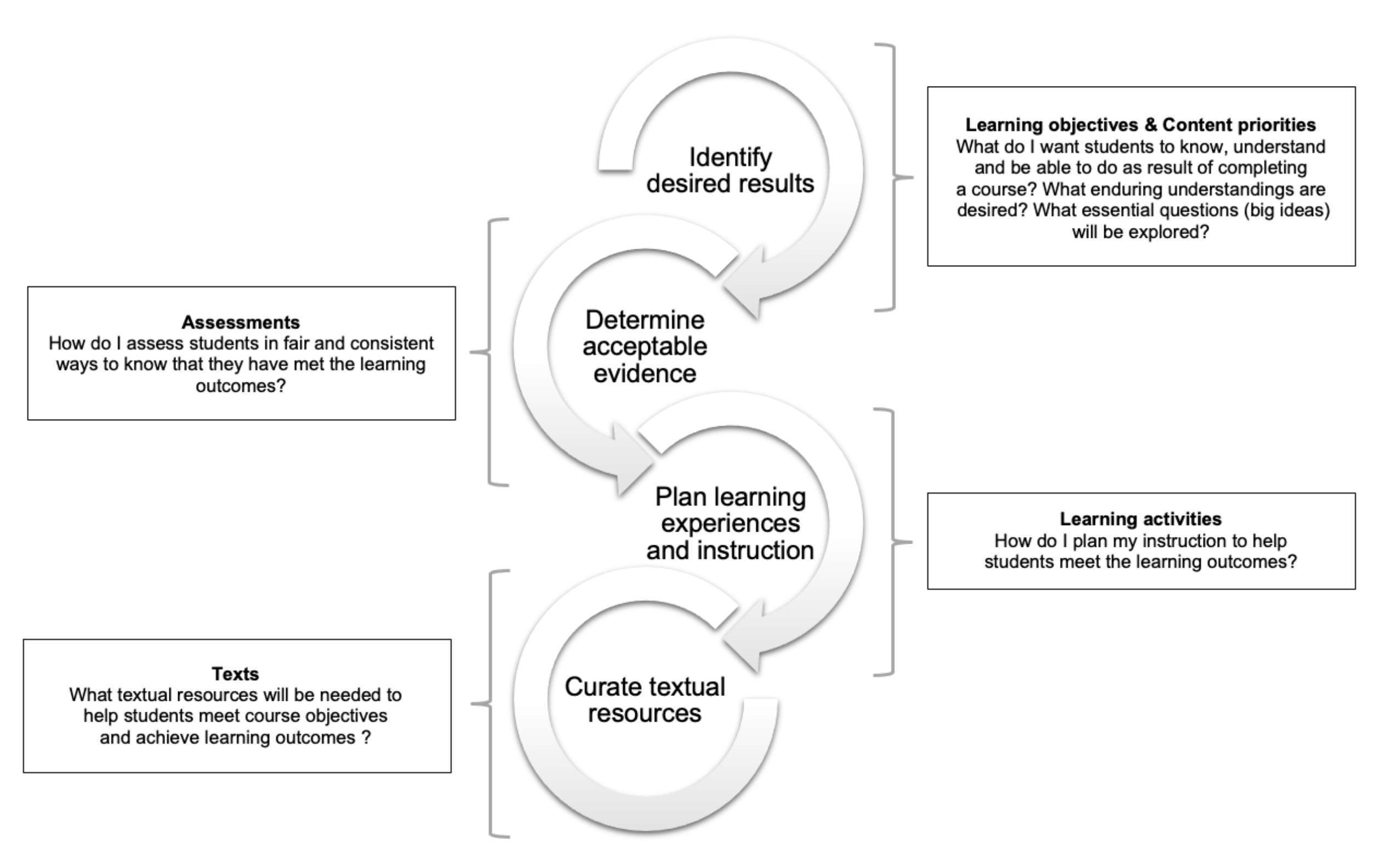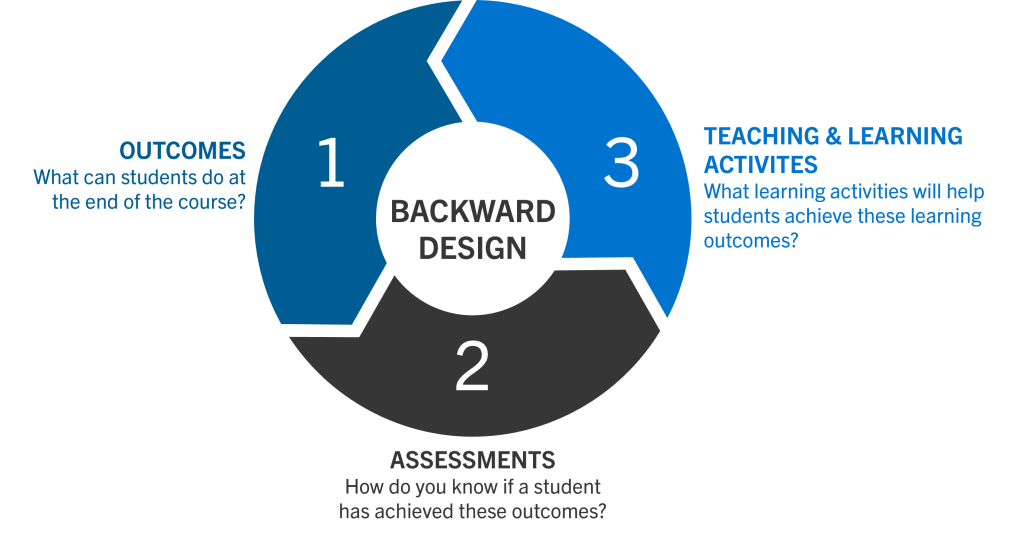Table Of Content

Wiggins and McTighe identify a link between the assessment format and the type of understanding students need to demonstrate. For example, if the goal is for students to learn basic facts and skills, traditional quizzes and tests might be the most appropriate type of assessment to use. However, when the goal is enduring understanding, more complex and authentic assessment strategies might be needed to assess student learning.
Share This Book
Work Backwards: A Design Thinking Approach To Higher Education - Forbes
Work Backwards: A Design Thinking Approach To Higher Education.
Posted: Thu, 12 Jul 2018 07:00:00 GMT [source]
The backward design approach to curriculum planning enables educators to provide goal-centered instruction. With learning objectives centered, students can appreciate the relevance of the instructional content. The backward design approach for curriculum development applies to individual lesson plans through the backward mapping approach. In their excellent book, Understanding by Design, Wiggins and McTighe propose the “Backward Design” framework for course design. This framework is “backward” only to the extent that it reverses the typical approach, so that the primary focus of course design becomes the desired learning outcomes. Only when one knows exactly what one wants students to learn should the focus turn toward consideration of the best methods for teaching the content, and meeting those learning goals.
Instructional Design

Although backward design is based on the same components of the ADDIE model, backward design is a condensed version of these components with far less flexibility. Backward design arose in tandem with the concept of learning standards, and it is widely viewed as a practical process for using standards to guide the development of a course, unit, or other learning experience. Like backward designs, learning standards are a way to promote greater consistency and commonality in what gets taught to students from state to state, school to school, grade to grade, and teacher to teacher. We suggest that the Backward Design framework (Wiggins and McTighe, 2005) represents a more effective approach to both course design and redesign, and is appropriate regardless of whether the course takes the form of a lecture, discussion, or lab.
The Derek Bok Center for Teaching and Learning
This fully online program is for anyone developing and/or teaching an online course.ADDIE Instructional Design Certificate Program (Fully Online). This fully online program is designed for individuals interested in learning more about the ADDIE model.Instructional Design Models Certificate (Fully Online). You will explore traditional instructional design models and the progression of the learning design approach to creating online learning experiences. The primary starting point for backward design is to become familiar with the standards/outcomes for the grade level and curriculum being taught. The second part of curriculum planning with backward design is finding appropriate assessments. It can be difficult for "traditional" educators to switch to this model because it is hard to conceptualize an assessment before deciding on lessons and instruction.
Advocates of backward design would argue that the instructional process should serve the goals; the goals—and the results for students—should not be determined by the process. Finally, instructors create learning activities and instructional materials that align with and support the achievement of the learning objectives. Since students will be only part of the way through the unit, and therefore may not yet have mastered the content, the goal of these mini-assessment will be to gauge abilities like critical thinking, inquiry, problem-solving and foundational knowledge. As previously stated, backward design is beneficial to instructors because it innately encourages intentionality during the design process. It continually encourages the instructor to establish the purpose of doing something before implementing it into the curriculum.
Step 3: Design Content for Instruction

Once we've designed an assessment, our final task—which brings us around to the "front" of Backward Design—is to plan our teaching, which should enable students to complete the assessment successfully, thereby demonstrating their learning. Lecturing, primary and secondary readings, student presentations, and debates are all possible ways of structuring student learning towards the eventual assessment. There are merits to both traditional lesson planning and backward lesson design, but key differences can create challenges for some teachers and students.
Creating a Roadmap for Success by Beginning at the End - Faculty Focus
Creating a Roadmap for Success by Beginning at the End.
Posted: Fri, 12 Jul 2019 07:00:00 GMT [source]
Stage 3: Plan Learning Activities and Instructional Materials
For example, you can create online quizzes, video lessons, and online group discussions to make the lessons more interactive. One of the first things you will need to do when starting your journey to using backward design for your course or lessons is to define your learning objectives. Learning objectives are statements that define what students will accomplish at the end of a course, unit, or lesson. In defining specific course goals, many teachers make use of A Taxonomy for Learning, Teaching and Assessing (Anderson, Krathwohl, 2001) as a guide. This taxonomy describes cognitive learning processes with respect to increasing levels of abstraction and complexity, from basic to advanced, around which goals can be organized.
Backward Design emphasizes the following elements in your lessons, units or courses:
By answering the three questions presented at this stage, instructors will be able to determine the best content for the course. Furthermore, the answers to question #3 regarding enduring understandings can be adapted to form concrete, specific learning goals for the students; thus, identifying the desired results that instructors want their students to achieve. Traditionally, instructors have applied a forward or content-centered approach to designing lessons, modules, or courses. This approach typically ends with crafting learning objectives to connect the content learned to the assessments. Backward design helps teachers create courses and units that are focused on the goal (learning) rather than the process (teaching). Because “beginning with the end” is often a counterintuitive process, backward design gives educators a structure they can follow when creating a curriculum and planning their instructional process.
Formplus - For Seamless Data Collection
Learning outcomes and/or objectives should target complex skills and knowledge, by implementing Bloom's terminology into a learning outcome instructors can help students understand what they need to do in order to meet the desired results. How will students be able to know they have succeeded in learning the core concepts and competencies? Consider various forms of both formative and summative assessment (see more in the assessment tab below). Furthermore, when a teacher designs a lesson without a plan for the final assessment, they may be tempted to add activities or units to the lesson just for the sake of filling class time. Students of all ages know when they are asked to do something pointless in class; they can spot “busy work” from a mile away, and will disengage as they see fit.
Wiggins and McTighe have created a six-part checklist built on the acronym WHERETO that consists of key elements that should be included in your instructional materials and learning activities. Assessment refers to the wide variety of methods or tools that educators use to evaluate, measure, and document the academic readiness, learning progress, skill acquisition, or educational needs of students. Do students need to know this to succeed in obtaining the core concepts and competencies? By creating a curated framework, instructors can teach students how to learn in the discipline rather than focusing on content coverage (Peterson et al. 2020). In other words, a superior education will teach students to think and practice like scientists. If we don’t plan learning experiences that make that possible, we’re giving them a sub-par education.
In addition, it is helpful to ask yourself what the impact of the course will be on students, and how you hope they will be different by the end of it. In order for students to demonstrate whether they've accomplished the objective we set, the paper they write or the exam they take has to evaluate that objective specifically. Both the form and content of the assessment can facilitate (or hinder) that evaluation. Asking students to provide dates of battles, names of generals, and pre-war compromises assesses recall of facts, but not analysis or argumentation. Similarly, a multiple choice format that asks students to pick the most important cause of the war out of a set of four fails to provide the opportunity for in-depth comparison. Our first sample objective from above, for example, is probably best assessed through an essay format, one that asks students to compare more and less important causes of the Civil War.
The first question listed above has instructors consider the knowledge that is worth being familiar with which is the largest circle, meaning it entails the most information. The second question above allows the instructor to focus on more important knowledge, the knowledge and skills that are important to know and do. Finally, with the third question, instructors begin to detail the enduring understandings, overarching learning goals, and big ideas that students should retain.

No comments:
Post a Comment